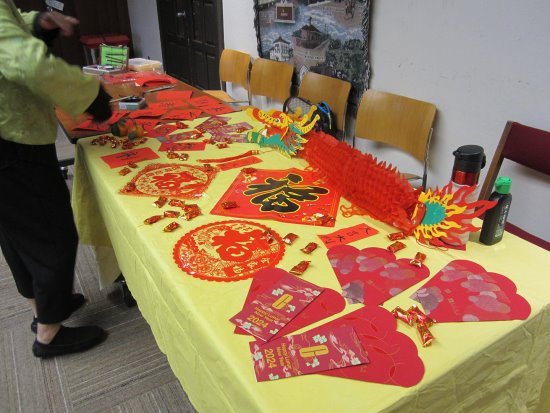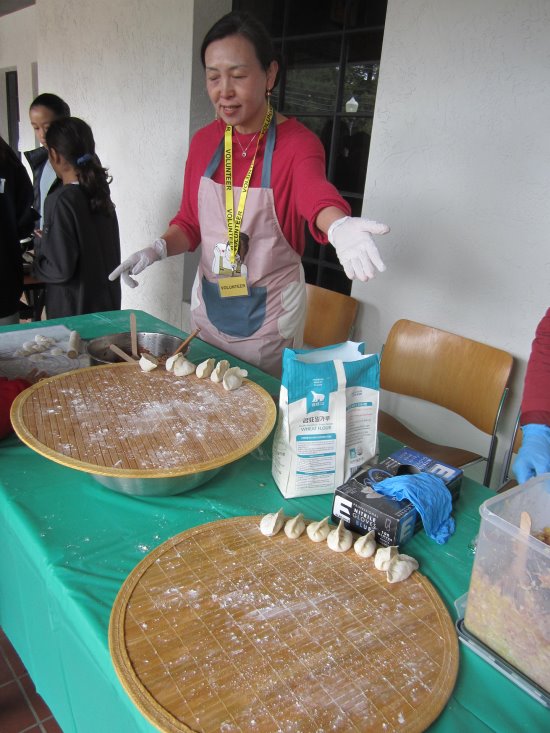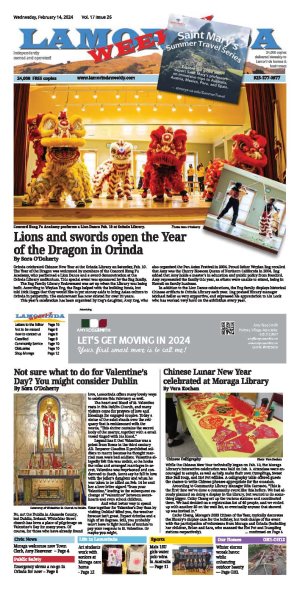| | Published February 14th, 2024
| Chinese Lunar New Year celebrated at Moraga Library
| | | By Vera Kochan |  | | Chinese Calligraphy Photo Vera Kochan |
While the Chinese New Year technically began on Feb. 10, the Moraga Library's interactive celebration was held on Feb. 3. Attendees were encouraged to sample, as well as help make their own Dumplings, Sweet Rice Ball Soup, and Hot Pot edibles. A calligraphy table offered guests the chance to write Chinese phrases appropriate for the occasion.
 According to Community Library Manager Rita Carrasco, "This is the first time we've done a community event like this before. We had already planned on doing a display in the library, but wanted to do something bigger. Cathy Chang set up the various stations and coordinated them. We had decided on a registration list of 40 people, and we ended up with another 20 on the wait list, so eventually anyone that showed up was invited in."
According to Community Library Manager Rita Carrasco, "This is the first time we've done a community event like this before. We had already planned on doing a display in the library, but wanted to do something bigger. Cathy Chang set up the various stations and coordinated them. We had decided on a registration list of 40 people, and we ended up with another 20 on the wait list, so eventually anyone that showed up was invited in."
 Cathy Chang, Moraga's 2023 Citizen of the Year, typically decorates the library's display case for the holiday, but took charge of the event with the participation of volunteers from Moraga and Orinda (including her children, Brian and Sara, who manned the Hot Pot and Dumpling stations respectively). "Every station had at least one adult and one student," explained Chang, "because we wanted to have the kids experience volunteering, in addition to passing on their culture to others. The Friends of the Moraga Library sponsored the event and paid for the food; and the lobby display will be up through the month of February."
Cathy Chang, Moraga's 2023 Citizen of the Year, typically decorates the library's display case for the holiday, but took charge of the event with the participation of volunteers from Moraga and Orinda (including her children, Brian and Sara, who manned the Hot Pot and Dumpling stations respectively). "Every station had at least one adult and one student," explained Chang, "because we wanted to have the kids experience volunteering, in addition to passing on their culture to others. The Friends of the Moraga Library sponsored the event and paid for the food; and the lobby display will be up through the month of February."
 According to the Chinese calendar, the year you were born could determine your personality, and each year in the lunar cycle of 12 is represented by an animal. This year, 2024, is the Year of the Dragon, and those born under its sign are gifted with courage, tenacity, intelligence, and confidence. The celebrations last for 15 days, with different activities happening throughout the period.
According to the Chinese calendar, the year you were born could determine your personality, and each year in the lunar cycle of 12 is represented by an animal. This year, 2024, is the Year of the Dragon, and those born under its sign are gifted with courage, tenacity, intelligence, and confidence. The celebrations last for 15 days, with different activities happening throughout the period.
 In the days leading up to Chinese New Year's Day, intense house cleaning (to sweep away bad luck) and shopping to prepare for the celebration begins. Putting up spring couplets or banners adds blessings to the house, visiting graves of loved ones and bringing offerings expresses remembrance, and having "reunion dinners" stresses the fact that wherever anyone may be, people are expected to come home to celebrate the festival with several generations of their family enjoying the food and time together.
In the days leading up to Chinese New Year's Day, intense house cleaning (to sweep away bad luck) and shopping to prepare for the celebration begins. Putting up spring couplets or banners adds blessings to the house, visiting graves of loved ones and bringing offerings expresses remembrance, and having "reunion dinners" stresses the fact that wherever anyone may be, people are expected to come home to celebrate the festival with several generations of their family enjoying the food and time together.
 Giving red envelopes containing "lucky money" are given to children and retired seniors. Red is the holiday's main color -- it symbolizes good fortune and joy. Just like any New Year celebration, revelers are expected to stay awake till at least midnight.
Giving red envelopes containing "lucky money" are given to children and retired seniors. Red is the holiday's main color -- it symbolizes good fortune and joy. Just like any New Year celebration, revelers are expected to stay awake till at least midnight.
 The Chinese New Year begins with setting off firecrackers on the stroke of midnight (this is meant to scare away evil and welcome the new year). The week after involves visiting with friends and relatives, and by the eighth day most people return to work. The fifteenth day is for lighting lanterns, eating sweet dumplings, and more fireworks.
The Chinese New Year begins with setting off firecrackers on the stroke of midnight (this is meant to scare away evil and welcome the new year). The week after involves visiting with friends and relatives, and by the eighth day most people return to work. The fifteenth day is for lighting lanterns, eating sweet dumplings, and more fireworks.
 The Library's celebration included a calligraphy table for attendees to try their hand at writing in Chinese using traditional methods. "Chinese New Year couplets are pairs of poetic lines, typically written in calligraphy with gold or black ink on red paper, representing well-wishes, blessings, and hopes for the future," stated an informational guide at the table. "They are an essential part of the festive decorations and are believed to bring good luck and fortune to the household. Paired couplets are typically placed on both sides of the front door, forming a harmonious and symmetrical display. Banners with simple phrases or a single character can be displayed on windows or at doors."
The Library's celebration included a calligraphy table for attendees to try their hand at writing in Chinese using traditional methods. "Chinese New Year couplets are pairs of poetic lines, typically written in calligraphy with gold or black ink on red paper, representing well-wishes, blessings, and hopes for the future," stated an informational guide at the table. "They are an essential part of the festive decorations and are believed to bring good luck and fortune to the household. Paired couplets are typically placed on both sides of the front door, forming a harmonious and symmetrical display. Banners with simple phrases or a single character can be displayed on windows or at doors."
 The enticing aroma that emanated from the food stations was enough to make stomachs growl with envy. There are seven foods that are considered lucky during the celebration period. Fish brings an increase in prosperity; Dumplings, Spring Rolls, and certain types of fruit bring wealth; Sweet Rice Balls bring family togetherness; glutinous Rice Cakes bring a higher income/position; and Noodles bring longevity.
The enticing aroma that emanated from the food stations was enough to make stomachs growl with envy. There are seven foods that are considered lucky during the celebration period. Fish brings an increase in prosperity; Dumplings, Spring Rolls, and certain types of fruit bring wealth; Sweet Rice Balls bring family togetherness; glutinous Rice Cakes bring a higher income/position; and Noodles bring longevity.
 Some Hot Pot ingredients are fish, tofu, Napa cabbage, mushrooms, sliced pork, or noodles, which were available for folks to put into a community Hot Pot (a type of broth/vegetable-filled soup) and scoop out their share when cooked. It is customary to have plenty of ingredients on hand, because guests should not leave the table hungry.
Some Hot Pot ingredients are fish, tofu, Napa cabbage, mushrooms, sliced pork, or noodles, which were available for folks to put into a community Hot Pot (a type of broth/vegetable-filled soup) and scoop out their share when cooked. It is customary to have plenty of ingredients on hand, because guests should not leave the table hungry.
 At the Dumpling station, pre-made fillings of pork or vegetarian were on-hand for people to place onto a round flat piece of dough to fold and crimp before boiling. Eating the crescent-shaped dumpling (which resembles ancient Chinese currency) signifies ushering in wealth for the coming year. Other typical fillings include beef, fish, and shrimp.
At the Dumpling station, pre-made fillings of pork or vegetarian were on-hand for people to place onto a round flat piece of dough to fold and crimp before boiling. Eating the crescent-shaped dumpling (which resembles ancient Chinese currency) signifies ushering in wealth for the coming year. Other typical fillings include beef, fish, and shrimp.
 Sweet Rice Balls, "Tangyuan," made of glutinous flour and water are kneaded into a smooth dough, and a small percentage is boiled until it floats. That, in turn, is incorporated back into the original dough and mixed until smooth. Small pieces of the dough are broken off and rolled into balls for boiling in water. The cooked Tangyuan is then added to a small amount of broth containing brown sugar and warm water. This dessert is meant to represent the first full moon of the year and encourages togetherness.
Sweet Rice Balls, "Tangyuan," made of glutinous flour and water are kneaded into a smooth dough, and a small percentage is boiled until it floats. That, in turn, is incorporated back into the original dough and mixed until smooth. Small pieces of the dough are broken off and rolled into balls for boiling in water. The cooked Tangyuan is then added to a small amount of broth containing brown sugar and warm water. This dessert is meant to represent the first full moon of the year and encourages togetherness.
 You can't visit a library without expecting to learn something, so Moraga's handed out a sheet containing eight questions that could be answered if attendees knew where to look. Completed quiz sheets were turned in and, if answered correctly, winners were given red envelopes filled with candy or other prizes.
You can't visit a library without expecting to learn something, so Moraga's handed out a sheet containing eight questions that could be answered if attendees knew where to look. Completed quiz sheets were turned in and, if answered correctly, winners were given red envelopes filled with candy or other prizes.
 Gung Hay Fat Choy!! Happy New Year!!
Gung Hay Fat Choy!! Happy New Year!! |
 | | Dumpling station Photo Vera Kochan | | | | | | | | | | | |




